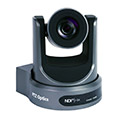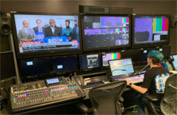PTZOptics Live Streaming Checklist
Courtesy of “Streaming Idiots” and PTZOptics Facebook Group Members see their links below!
- 1. Planning
- A. Site Survey
- a. Google Earth the Site Survey – Scott Pienta
- b. Draw a map of your camera placement – JP Erbricella
- c. Circle connections and caption what they are. Double check all your cables and connectors with this map.
- d. Make sure every element is covered including Tripods, cables, power supplies and stands.
- e. Map out your video then your audio.
- f. Create a checklist to keep track of your components once they you've packed them. – Ted Langdell
- B. Setting up a Live Show Layout
- a. This includes all the software related to your show. Prepare a manageable set of video assets including: intro video, titles, additional video sources, media and other content.
- C. Power
- a. Where and what is your power source? Is it clean and independent from the lighting and sound grids? – Sheldon Hatch
- D. Cabling
- a. Set cables longer than 50 feet onto spools for easy in and out rigging. Great for Ethernet, power and audio. – Ken Benedict
- E. Extra Equipment
- a. Always bring flashlights if the production is going to last into the night.
- b. Bring gaff tape to tape down cables. Yellow tapes for high traffic areas and black for everything else. – Ken Benedict
- F. Weather
- a. Bring trash bags or tarps to cover your valuable equipment from rain and other elements.
- G. Run through the show with the Talent
- a. Uncover technical issues and prepare your team with a pre-show walk through.
- 2. Tuning your Equipment
- A. Lights – Before you start tuning your camera make sure you're lighting is on and ready for action.
- B. Camera – Tune you camera for good contrast, luminance, saturation and hue in your room. When using a green screen with a chroma key background, pay special attention to hues and contrast. The goal is to provide a rich image with strong whites and blacks and a wide range of accurately represented colors.
- a. White Balance: Start with an auto-white balance. Do this by holding up a piece of white paper and selecting the “one push” white balance feature on any PTZOptics camera's on-screen menu display. Note: Some software solutions also offer a white balance feature. Follow best practice and tune the image in your camera first, before tuning with software.
- b. Focus: Obviously you want your talent in focus, but consider whether you always need auto-focus. When your talent won't be moving much, your best choice is manual focus, to avoid unintended camera auto-focus on hand movements and body gesturing. When your talent will be moving around a stage or wide area, the best choice is still auto-focus. Tip: Avoid swivel chairs and suggest seating your talent on a stool or four legged chair with a short back.
- c. Video Tutorial on Camera Exposures – https://www.youtube.com/watch?v=U9EgrHiliyw
- C. Microphones – Test your microphone(s) before your event. Tuning may only need to be done periodically if your microphone is used in similar settings. Listen for a wide range of highs and lows. Check you audio meter to make sure your levels are in a safe range and not spilling into the “red zone.”
- D. Green Screens – Using chroma key technology can be challenging without good lighting and a reflecting green surface. Assuming you have an ideal green background, select the exact color your camera is outputting to your software with the color picker tool then adjust your settings until you're happy with your chroma key. TIP 1: Using a dark background will help hide stray pixelation.
- 3. Hard Drive Space Check for Recording
- A. Will you be recording the live stream locally? Locally recorded quality is always better than an outbound live stream. Do you have enough hard drive space for the entire live broadcast? Will you use instant-replay? That too requires additional recording space.
- B. Start recording early! Better to start early than forget too late!
- 4. Testing Bandwidth
- A. Test your bandwidth speeds with our free tool at http://speed.ptzoptics.com
- B. Optimize your bandwidth and make suggestions for remote guests joining via video conference. See our Live Streaming Bandwidth Checklist here: https://ptzoptics.com/landing/live-streaming.html
- C. Determine the maximum capabilities of your system to choose video resolution and audio compression streaming configurations.
- D. Don’t use WiFi if you can help it!
- E. Bring a back up wireless 4G/5G router like the "LiveU solo."
- 5. Establishing Your Live Stream
- A. Do a Test Stream
- B. Make sure to have your RTMP Server and key information ready. You'll use this information to start streaming to your CDN (Content Delivery Network).
- C. Another best practice is to start your live stream at least 20-30 minutes before the event. During this time, be sure to display a countdown timer and some type of “Streaming Soon” placeholder with background music. The time before your event is ideal for targeting viewers with automated messages.
- D. Consider using your CDNs API. Sometimes custom RTMP streams don't include all the information networks like Facebook use to power their live streaming (MAP for example).
- 6. Social Media Integration
- A. Will you be integrating social media comments into your broadcast? If so, remember to login to your accounts to pull data?
- B. You can use services like Zapier and Dropbox to automatically publish short clips and recordings while broadcasting on social media sites like Facebook and Twitter. This can drive additional traffic to your live event.
- 7. Final Testing
- A. Test your audio again, but this time listen to the stream as if you were a viewer. Live streams are known for randomly introducing audio syncing issues with no rhyme or reason. The good news is that you can add an audio delay to compensate. When needed, add 2000-3000 milliseconds (2-3 seconds) to your audio delay until all syncing issues iron out.
- 8. During Your Stream
- A. Pay attention to your CPU usage. Generally, you never want to go beyond 50-70%.
- B. Listen to the audience. Are they asking for a different video angle? Do they want to hear changes in the audio? You might be surprised how technical your audience is.
- C. To avoid seeing see notifications from your live streaming software about CPU usage while you stream; always turn off all other programs and disable windows updates.
- D. Mute Your Computers and Cell Phones.
- 9. Channel Management
- A. Don’t forget to set up a reasonable “channel blacklist.” This is a feature that lets you restrict words from displaying in the chat room.
- B. Don’t forget to have your live stream displayed in the “schedule” system. You can also configure settings in YouTube to promote your live event on other videos.
- C. Don’t forget to ask for subscribers. Grow your channel during your live event when you've got everyone’s attention!
- 10. General Tips
- A. Don’t forget to share your live show on social media.
- B. Don’t forget, best practice is to reserve time in the chatroom specifically for Q&A.
- C.Finally, consider the Outro. What are you business goals? Is it a free eBook or an upcoming webinar? Don’t forget to include a Call to Action (CTA) for participants. Maybe simply asking for new subscribers!


















